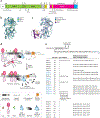FERONIA: A Receptor Kinase at the Core of a Global Signaling Network
- PMID: 38424067
- PMCID: PMC12034098
- DOI: 10.1146/annurev-arplant-102820-103424
FERONIA: A Receptor Kinase at the Core of a Global Signaling Network
Abstract
Initially identified as a key regulator of female fertility in Arabidopsis, the FERONIA (FER) receptor kinase is now recognized as crucial for almost all aspects of plant growth and survival. FER partners with a glycosylphosphatidylinositol-anchored protein of the LLG family to act as coreceptors on the cell surface. The FER-LLG coreceptor interacts with different RAPID ALKALINIZATION FACTOR (RALF) peptide ligands to function in various growth and developmental processes and to respond to challenges from the environment. The RALF-FER-LLG signaling modules interact with molecules in the cell wall, cell membrane, cytoplasm, and nucleus and mediate an interwoven signaling network. Multiple FER-LLG modules, each anchored by FER or a FER-related receptor kinase, have been studied, illustrating the functional diversity and the mechanistic complexity of the FER family signaling modules. The challenges going forward are to distill from this complexity the unifying schemes where possible and attain precision and refinement in the knowledge of critical details upon which future investigations can be built. By focusing on the extensively characterized FER, this review provides foundational information to guide the next phase of research on FER in model as well as crop species and potential applications for improving plant growth and resilience.
Keywords: GPI-AP; RAC/ROP; RALF; RAPID ALKALINIZATION FACTOR; ROS; cytoplasmic pathway; extracellular matrix; glycosylphosphatidylinositol-anchored protein; growth; nuclear pathway; reproduction; survival.
Figures



References
-
- Anderson CT, Kieber JJ. 2020. Dynamic construction, perception, and remodeling of plant cell walls. Annu. Rev. Plant Biol 71:39–69 - PubMed
Publication types
MeSH terms
Substances
Grants and funding
LinkOut - more resources
Full Text Sources
Miscellaneous

